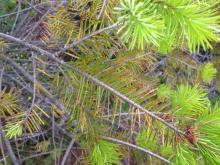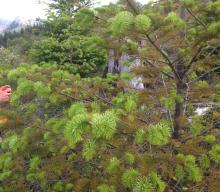See:
Fir, Douglas (Pseudotsuga menziesii) - Needle Cast, Swiss
Cause Rhabdocline spp. including R. pseudotsugae and R. weirii and 3 other species, fungi. They perpetuate themselves from year to year in needles on the tree. Ascospores are released in spring at the same time as the unfolding of new shoots. Infection occurs mainly on these new needles but may occur later with continued wet weather. Greatest losses result from the trees' unsightliness, which renders them unsalable. Severe losses also occur from the less conspicuously affected trees whose needles discolor and drop during transit and marketing.
Coastal Douglas-fir grown west of the Cascade Range are generally resistant to these fungi. Intermountain or Rocky Mountain Douglas-fir has a wide range of susceptibility when grown in western Oregon and Washington. Trees from the Cibola National Forest (NF) are very susceptible while trees from the Apache NF, San Isabel NF, Lincoln NF and Santa Fe NF have intermediate susceptibility. Trees from the Carson NF, Coconino NF, Rio Grande NF and Upper Clearwater, Idaho have much less disease development. s
Symptoms The first evidence of the disease appears in the autumn or early winter as minute yellow spots on upper and lower surfaces of current-year needles. Usually, spots are more abundant near the needle's apex. Spots become larger and darker during winter. By spring, many spots coalesce and become deep red-brown with a mottled appearance. Fruiting bodies (apothecia) of the fungus appear on each side of the midrib on the needle's lower surface. The needle's epidermis lifts up as a patch, exposing an orange to orange-brown fungus structure. Infected needles fall off by late June.
Cultural control
- Avoid planting in low-lying areas with poor air drainage.
- Space plants for good air circulation.
- Control weeds around the bases of trees.
- Remove and destroy infected trees from Christmas tree plantations.
- Avoid using east-side and Rocky Mountain seed sources.
Chemical control Make first applications when new growth is 1 to 2 inches long and an additional application 3 weeks later.
- Chlorothalonil (Bravo Weather Stik, Daconil Weather Stik, Echo 720). Use Bravo Weather Stik at 1.5 to 2.75 pints/A. Group M5 fungicides. 12-hr reentry.
- Copper-based products. Group M1 fungicides. O
- Champ Dry Prill at 1.33 lb/A. 48-hr reentry.
- CuPRO 5000 at 1.5 to 5 lb/A but only up to 2 lb/A when new growth is present. 48-hr reentry.
- Cuprofix Ultra 40 Disperss at 1.25 lb/A. 48-hr reentry.
- Kocide 50 DF at 1.5 to 4 lb/A. 48-hr reentry.
- Nu-Cop 50 DF at 2 to 4 lb/A. 48-hr reentry.
- Heritage at 3.2 to 8 oz/A plus a non-silicone-based wetter sticker for Christmas tree use. Was not as good as chlorothalonil in Pennsylvania tests. Group 11 fungicide. 4-hr reentry.
- Mancozeb-based products. Group M3 fungicides. 24-hr reentry.
- Dithane M45 at 2 to 4 lb/A or per 100 gal water. 14-day PHI. Registered for use on Christmas trees.
- Fore 80 WP at 1.5 lb/100 gal water plus a spreader-sticker. Registered for outdoor or greenhouse use.
- Penncozeb 75 DF at 2 to 4 lb/A. 14-day PHI. Registered for use on Christmas trees.
- Protect DF at 1 to 2 lb/100 gal water plus 2 to 4 oz spreader-sticker. Registered for field, nursery and greenhouse grown plants including Christmas trees.
- Ortho MAX Garden Disease Control at 5 teaspoons/4 gal water. H
- Quadris at 6.2 to 15.4 fl oz/A for Christmas tree use. Was not as good as chlorothalonil in Pennsylvania tests. 4-hr reentry.
- Spectro 90 WDG at 1 to 2 lb/100 gal water. Registered for conifers grown in nursery, greenhouse or landscape. Group 1 + M5 fungicide. 12-hr reentry.
- Tourney EZ at 2 to 4 oz/100 gal water. Registered for ornamentals. Group 3 fungicide. 12-hr reentry.
References Chastanger, G.A. 2001 Susceptibility of intermountain Douglas-fir to Rhabdocline needle cast when grown in the Pacific Northwest. Plant Health Progress doi:10.1094/PHP-2001-1029-01-RS.
Chastagner, G.A, Byther, R.S., and Riley, K.L. 1990. Maturation of apothecia and control of Rhabdocline needle cast on Douglas-fir in western Washington. In: Merrill, W. and Ostry, M.E. (eds.) Recent Research on Foliage Diseases. General Technical Report WO-56. Washington, DC: USDA Forest Service.




